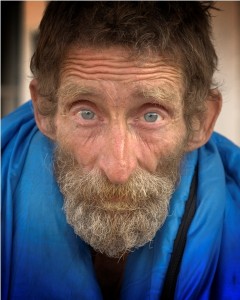Larger-Than-Real-Life Characters

Then I noticed the guy who came into the coffee shop panting, a backpack slung over his gray sweatshirt that was ripped at the shoulder and soaked, his pants tattered at the cuff. He grabbed the free water, sweat dripping from his forehead, and hunched over just a bit…obviously overheated. I watched him out of the corner of my eye. He downed the water, filled his cup again, and set his backpack by the computer, telling the barista he’d order something…but in a bit. I wondered…who is this guy? What’s his story?
He looked out of place in a yuppy coffee shop, but ordered a frozen drink. Was he homeless? I didn’t think a homeless person would spend $5 on a drink. Down on his luck? Maybe. Running from an axe murderer? Probably not. So why was he there? Where had he just come from? And why was he wearing a sweat shirt on a 100 degree day?
This is the second time in two weeks in two different coffee shops that I’ve witnessed an “out of place,” larger-than-real-life character that made me stop and ask “What’s his story?”
In “Writing the Break Out Novel,” Donald Maass talks about larger-than-life character qualities. He says, “A larger-than-life” character is someone who says, does, and thinks things that we would like to but never dare. This does not necessarily mean turning your characters into wise-crackers or pulp clichés. It does mean pushing them out of their own bounds, whatever those might be.”
It also means putting them in out of the ordinary situations.
Those are the kind of characters and stories people like to read about and those are the characters we need to write. The affectionate couple in the corner were ordinary. I gave them a once over, then moved on.
I. Moved. On.
To something more interesting. Someone more interesting.
My challenge and encouragement for you is to create larger-than-life characters so your readers can’t move on, but are compelled to ask “what’s his story?”
And then go tell it!